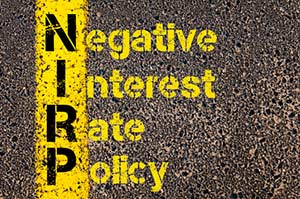 Best Investments: Last week, former Fed Chair Ben Bernanke suggested the Federal Reserve should contemplate using negative-interest-rate policy (NIRP) in order to prop up the economy. But what Bernanke doesn't get is that negative interest rates are disastrous to the global economy.
Best Investments: Last week, former Fed Chair Ben Bernanke suggested the Federal Reserve should contemplate using negative-interest-rate policy (NIRP) in order to prop up the economy. But what Bernanke doesn't get is that negative interest rates are disastrous to the global economy.
That's why we're bringing readers the best investments to make now as the use of negative interest rates picks up globally.
The use of negative interest rates is increasing worldwide as policymakers run out of tools to spur growth. Here are some key details about the increasing - and frightening - use of negative interest rates.
Why Negative Interest Rates Are Becoming So Popular
Central banks around the globe have resorted to some unconventional methods, including negative rates, to drive economic growth in their countries. Some believe it's only a matter of time before the U.S. Federal Reserve starts toying with negative rates.
Fed Chair Janet Yellen rattled markets in early May when she said she "would not completely rule out the use of negative interest rates in some future adverse scenario."
Then Bernanke made his comments last week. Bernanke wrote in a blog post that venturing into negative interest rates may not be as drastic as it seems.
Get Our Best Wealth-Building Ideas: Money Morning's top 5 investment reports to grow your money like never before are right here - and they're absolutely free. Read more...
"It would be extremely helpful if central banks could count on other policymakers, particularly fiscal policymakers, to take on some of the burden of stabilizing the economy during the next recession," Bernanke, now a consultant at Washington, D.C., think tank The Brookings Institute, wrote.
The European Central Bank, the Bank of Japan, and central banks in Sweden, Denmark, and Switzerland are all using negative interest rates. In fact, more than $11 trillion in global sovereign debt now carries a negative yield.
The Eurozone is trying to stimulate economic growth and raise inflation. Sweden is also trying to boost inflation. In Denmark and Switzerland, the objective is to prevent their currencies from rising too much. Negative interest rates discourage investors from buying the local currencies.
But so far the results have been mixed. Inflation levels have not climbed like central banks had hoped, and there have been no major economic improvements.
And because of the growing use of negative interest rates, investors everywhere have taken to hoarding cash. Large denominated notes are in hot demand overseas, and sales of home safes have surged.
"Negative interest rates are bad no matter which way you cut them and no matter how you try to justify them," Money Morning Chief Investment Strategist Keith Fitz-Gerald said.
According to Fitz-Gerald, these are the impacts that negative interest rates really have:
- Both investors and companies pay to borrow and are charged to save.
- The profit margins of lenders are squeezed, which makes them less likely to offer loans. Instead of borrowing, bank customers just withdraw their money in an attempt to protect it.
- Retail investors, institutional investors, and pension funds are forced into riskier assets in a frantic hunt for yield.
- Business confidence is undermined and they limit borrowing as CEOs won't risk their money while the economy is so fragile.
- Geopolitical tensions mount as countries try to protect themselves, even though the world's nations should be working together.
So what does all this mean for the dollar?
"Washington thinks the U.S. dollar is a weapon when, in fact, there are huge swathes of the world that believe it's a liability," Fitz-Gerald said. "Obviously, we can't do anything about what Bernanke thinks - that's a discussion for another time."
But what we can do know is help investors position their portfolios accordingly. And these are the best investments to make now as the use of negative interest rates continues to grow...
The Best Investments to Make Now as Negative Interest Rates Increase
It might seem crazy at first, but the comments made by both Yellen and Bernanke mean that investors should pile into U.S. dollars, according to Fitz-Gerald.
[mmpazkzone name="in-story" network="9794" site="307044" id="137008" type="4"]
No, that is not a typo...
"Conventional wisdom is that you want to sell Uncle Sam's greenbacks, but that's part of the same flawed economic modelling that got us into this mess," he added.
No other currency in the world can absorb the extra liquidity stemming from negative interest rates in the United States, so traders are going to pile into dollars.
In other words, the U.S. is the best house in a bad neighborhood.
Fitz-Gerald says the easiest way to play the dollar is with an exchange-traded fund (ETF) like the PowerShares DB U.S. Dollar Index Bullish Fund (NYSE Arca: UUP).
Another option is the Near-Term Tax Free Fund (MUTF: NEARX) from U.S. Global Investors. This fund invests in near-term municipal bonds with short maturities.
"It's a great 'cash alternative' for investors who can withstand a smidgen more risk... in dollars," Fitz-Gerald said.
One more choice is the Chinese yuan. China's economy is poised to become the largest in the world much sooner than most investors think. That means its currency, the yuan, will be solidly stronger against other currencies. Fitz-Gerald likes the WisdomTree Chinese Yuan Strategy Fund (NYSE Arca: CYB) for this play.
Give Your Portfolio a Much-Needed Edge: Chances are, your investing returns aren't where they could be if you had the proper tools. Learn how you can double your money in just days, profit on a trend that's gearing up to generate massive returns, give your portfolio a 325% performance advantage, and more. Click here...
Follow us on Twitter @moneymorning and like us on Facebook.
Related Articles:


